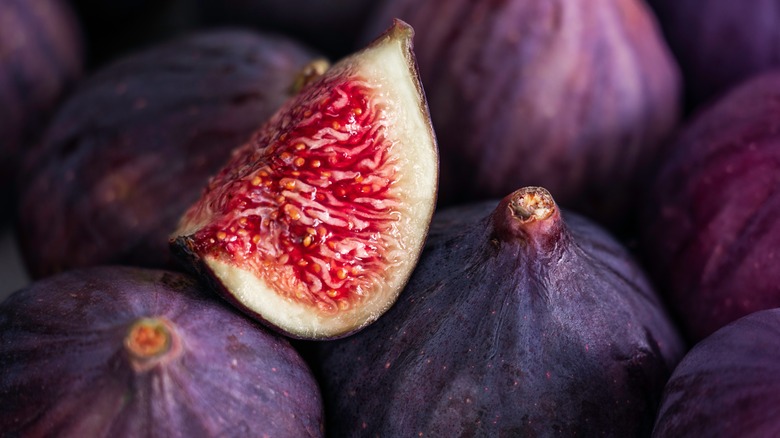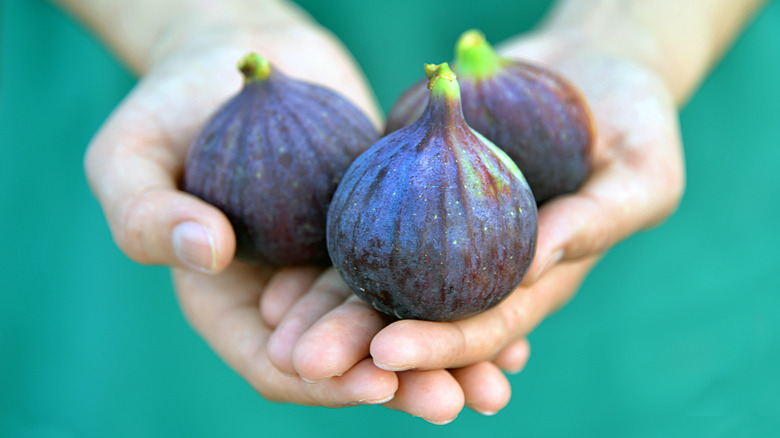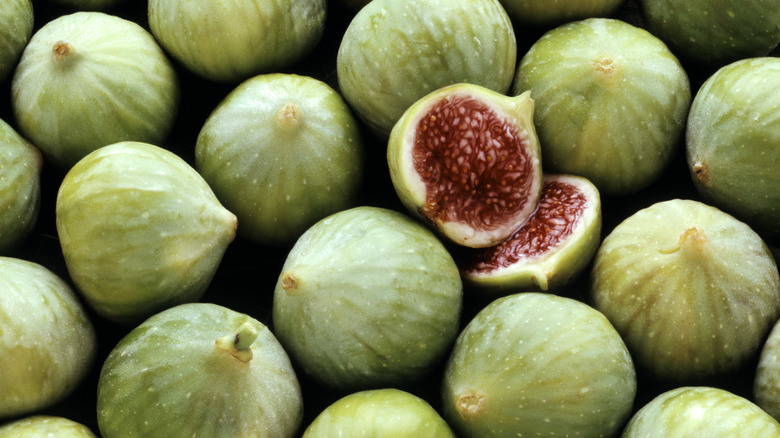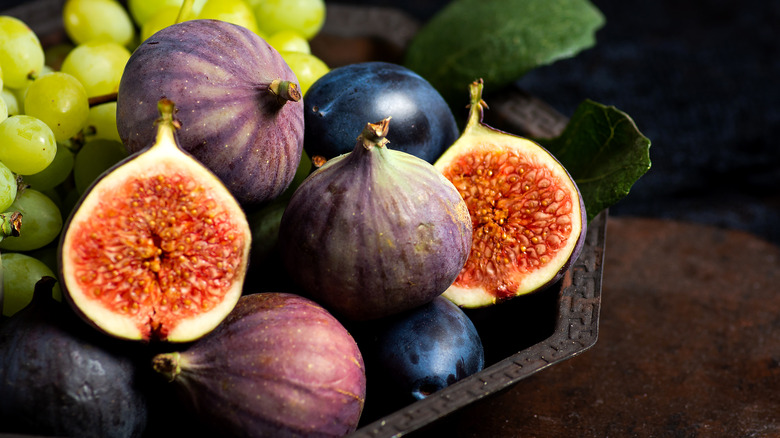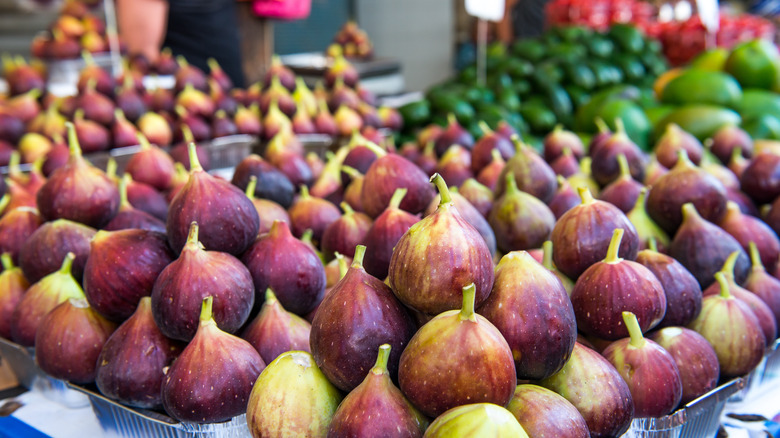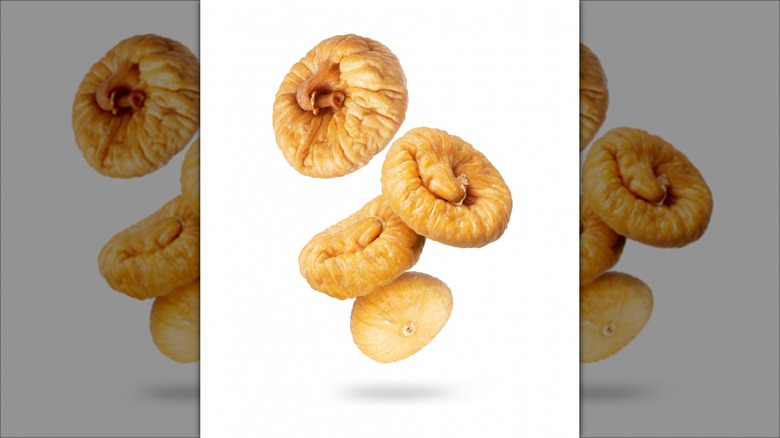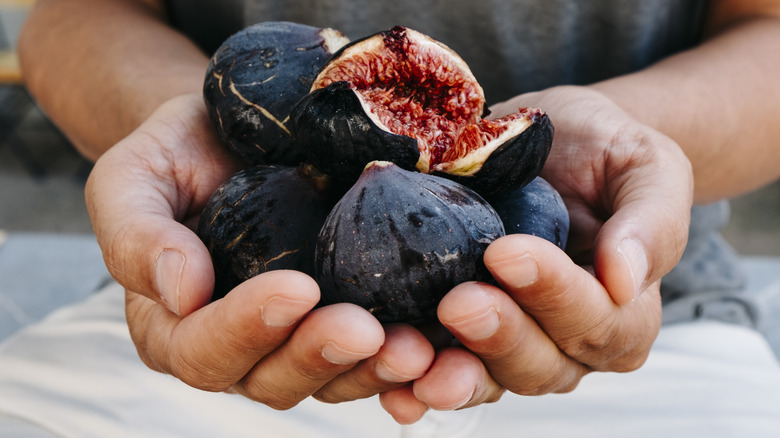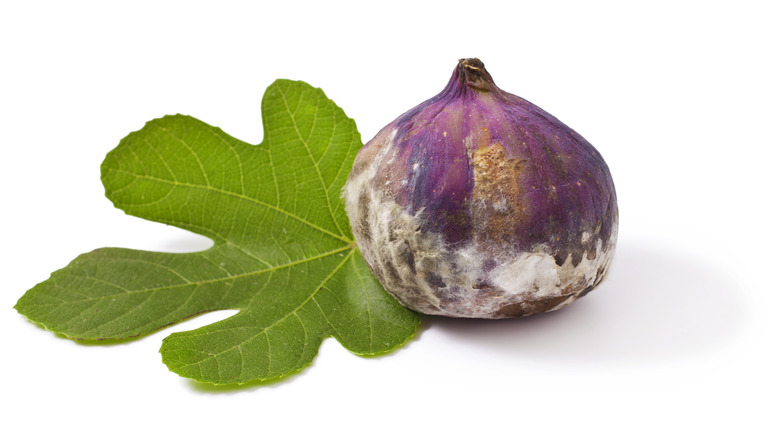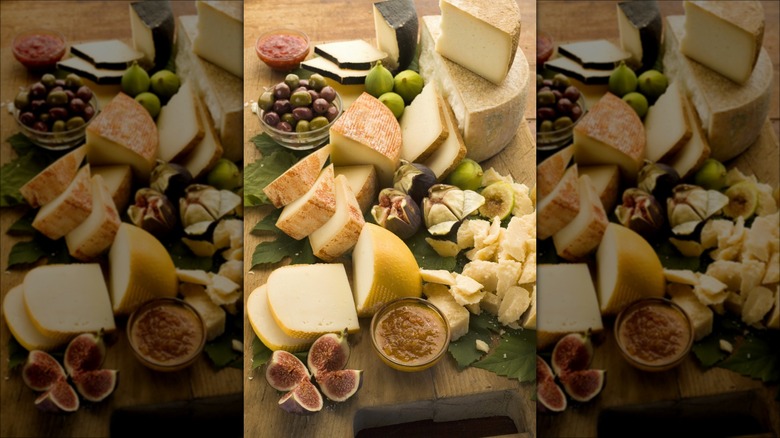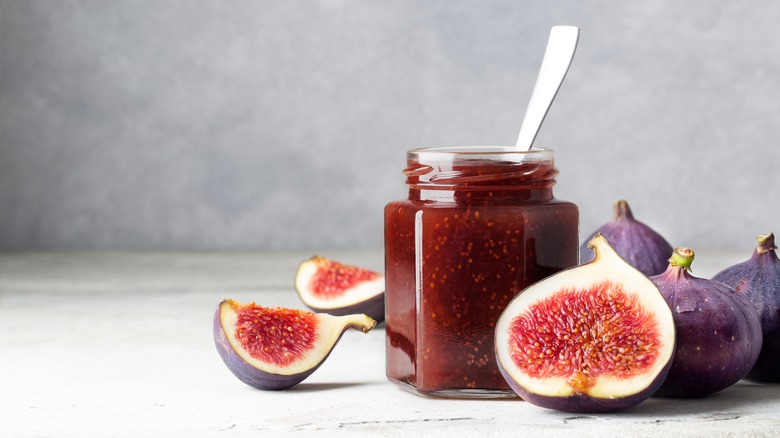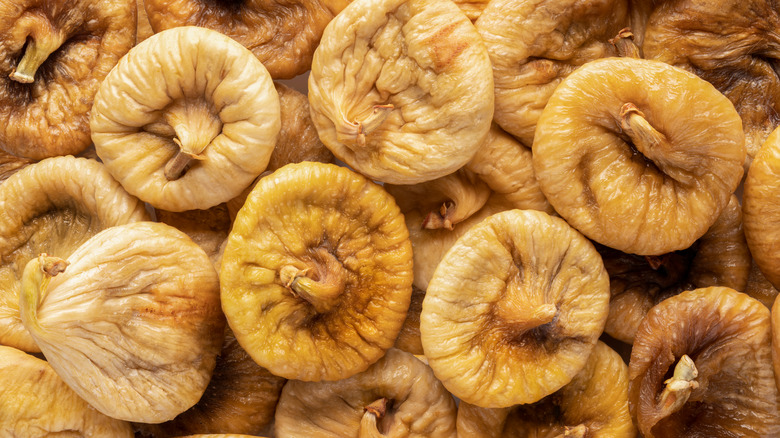The Easy Guide To Buying And Eating Figs
Come May, when Mother's Day is upon you, a conundrum presents itself. Do you give your mum a bouquet of flowers, or would a fruit basket be better? The answer to your challenge may arise from the oddest of places: the figs stall at the local farmer's market. As it turns out, figs aren't fruits at all. They're flowers, clusters of inverted flowers in pods, to be exact, and presenting your mum with a bunch of these satisfies the flowers-versus-fruit question on Mother's Day in one fell swoop.
All of this reveals what a complex goody you're working with when you buy figs. Not only are they beautiful and delicious, but they're extremely versatile as an ingredient. They're just right to eat straight off the vine and yet taste oh-so-good as a flavor complement to the goat cheese on your favorite pizza. Given their track record of people eating them for centuries — evidence suggests that people have grown them for over 11,000 years — it's clear that they've proven their worth on tables around the globe. As a cultivated crop, they have roots that go back even further than other agricultural staples, like legumes or wheat. While this fig guide might not answer the question of whether to call them fruits or flowers, it does offer numerous tips on what to look for when you're buying figs and how to eat them once you bring them home.
What to look for when buying
Figs are delicate and colorful like the flowers they are, and when you're buying them to eat, it's useful to remember this. For example, look for figs that give a little to the touch, that feel slightly soft and delicate in a way, just as you would a floral bloom. That said, you don't want to take home figs that are so soft and delicate that they feel mushy, are bruised, have developed mold, or have deep gashes in the skin. A scratch or two here and there is okay, but the scratches should only be surface scratches. On a related note, if figs smell like they've given up the ghost and have begun to rot, leave them where you found them.
The figs' color isn't always an indicator of ripeness because figs, like apples, come in different varieties with skins of different colors. You may find purple, green, or yellow figs, and all may be perfectly good figs. Incidentally, the same is true for the inside of the figs. If you're given a chance to see inside, take it. They sport different colors of pulp as well, from red to amber to gold. The interior color gives you a big clue about the fig's flavor profile.
They don't ripen once picked
Unlike kiwis or bananas, figs do not ripen once they're picked. If a fig feels hard to the touch in the grocery store, it'll continue to have that countenance until it goes south, so don't buy figs that aren't ripe in hopes they'll come to full ripeness sitting on your counter. When you squeeze ripe figs at the grocery store or market, you'll feel soft and give a little. If they feel firm, they were picked before they had a chance to ripen.
While this may not be as much of an issue if you buy figs from a grocery store or farmers' market, because presumably, the fig pickers know what to look for, you should keep this in mind because some unripe figs may have gotten through. It's also an important fact to remember if you go to a U-Pick farm to get your own. You'll be picking them without the experience of a fruit picker, so it's best to know what to look for, or you'll have unripe figs you can't eat on your kitchen counter.
There are hundreds of varieties
Fig varieties number into the hundreds or even thousands, depending on who you ask. Fortunately, a couple of fig types are more popular than others, narrowing down the number of figs you must try before finding one you like. The dark purple-colored black mission fig bursts in the center with a deep red interior. The ubiquity of this type explains why you see this sweet fig in so many photos. It's pretty much everywhere, to say the least. It's also the fig that Fig Newtons are made of, so chances are, you're very familiar with at least this type of fig in its dried form, even if you've tried no other kinds of figs.
Calimyrna and Adriatic figs both have green skins, though the Calimyrna are brighter and larger than Adriatic figs. Calimyrna figs open up to a pink interior, while the Adriatic figs hide a purple interior under their thick skins. Turkish figs have dark brown skins that are decorated with bits of green and purple. Inside, they're blush-colored and, compared to their mission counterparts, taste less sweet. Celeste, or sugar figs, have a bright pink interior that's covered by skins of light red or purple. If you're cooking with figs, it's critical to keep in mind that every fig variety has a slightly different taste and texture, which adds subtle flavor and texture differences to your recipes.
How much do figs cost?
A number of factors influence the cost of figs. First, figs generally have short shelf lives. In this case, when you buy a pound of figs, you're competing not only with other buyers but with Mother Nature herself. Most fresh figs will last long enough to allow you to get them home, but it's questionable after that. Second, their delicate natures and biting sap, which produces a reaction in some, mean picking them is challenging. This adds to the bottom line cost of the figs. Third, some may come from faraway places, kicking the supply and demand thing, and finally, if you buy dried figs, you'll also pay for production costs.
The bottom line? Figs can cost as little as $7 to $11 or more per pound if you buy them dry. Fresh fig prices also run the gamut, with some figs costing as little as $2 a pound, give or take, and others costing as much as $6 or more per pound.
How the nutritional values differ
Some nutritional differences exist between dried figs and fresh ones. However, there aren't that many. All in all, figs are a good-for-you choice, whether you eat them dried or straight off the vine. They may help to lower blood pressure as well as benefit the respiratory, immune, and digestive systems, per Healthline. Figs contain fiber, with dried figs being a particularly good source of it. From a caloric standpoint, dried figs boast significantly more calories than fresh ones do at 249 calories versus 37, respectively.
Figs contain important minerals like calcium, potassium, iron, and magnesium. They also come chock full of vitamin K, which may present a bit of a challenge to those who take blood thinners like warfarin. On a different note, unripe figs produce a type of latex as a defense. It's known to irritate the skin and eyes. If you have an allergy to latex, you may have a reaction to figs. Finally, if you like figs, eating two or three of them a day offers a quick and efficient way to get some vital nutrients in as well as providing quick bursts of energy due to their sugar and fiber content.
Figs are best enjoyed fresh
When it comes to eating fresh figs, that old adage, "It's not what's on the outside but what's on the inside that counts," holds true. The flavor comes from the flesh color inside. When you're eating fresh figs, keep that in mind above all else. For example, figs bursting with a ruby red interior taste like jam on toast without the toast. They're sweet and succulent.
Some figs are blessed with a very juicy, almost syrupy inside. Others are drier. Typically, the taste of figs has been described as a mix of berries and honey, though in what direction the taste leans for each type of fig varies. Some taste more like fruity berries and less like honey, while others taste more like honey or even sugar. Fresh figs are the kind of fruit that tastes great straight off the vine. Eat them skins and all. There's no need to peel them. Every part, except the stem, is edible.
Due to their natural sweetness, it's hard to beat them as a simple dessert if you like just a few pieces of plain, sweet fruit after a heavy dinner. Or get your morning started right by slicing up some fresh figs to fill your favorite honey-flavored yogurt with or to adorn your hot cereal. And at lunch, some slices of fresh figs bring a sweet freshness to your favorite salad recipes.
Fresh figs go bad quickly
Figs count among the most ephemeral foods around. If you bought them for a special occasion, the special occasion better be tonight or no later than two nights from the day you bought them because fresh figs go bad in a matter of a couple of days, a week at most. In other words, eat them yesterday, and you'll be good to go.
It's possible to extend the life of your figs by stashing them in the most frigid part of the fridge, but even this has its limits. Put them away in a shallow container or bowl. A tray works in a pinch, too. After a while, their taste begins to change in the fridge, and not for the better, as they don't really like cold climes very much. Set the temperature in your refrigerator between 32 and 36 degrees Fahrenheit for the best results. Finally, don't wash them until you're ready to eat them. Store them on the counter or in the fridge as is until then. They develop mold otherwise.
You'll find them at farmers markets from mid-summer to early fall
Typically, fresh figs come into season from May to November, depending on where they are grown. Start looking for figs in the early spring to the late fall to ensure that you don't miss them. It's also worth mentioning that different fig varieties have different "bloom" times, so you may see more than one type of fig in the store throughout the season.
Celeste figs, for example, have early harvest time. Look for purple or brown figs if you're interested in trying those. On the other hand, alma figs ripen later. Because of this, the fruit has time to grow sweet and tender. Tiger figs start peeking their heads out, so to speak, starting in mid-July, and you'll see them until November. And scout out dreamy green Kadota figs from June to October and Sierras, also green, from June to November. And of course, dried, frozen, or canned figs grace the shelves year-round.
On a related note, certain fig-growing areas are known for producing specific fig types. Figs from California are usually black mission, kadota, brown turkey, and Calimyrna. The Celeste and Chicago Hardy figs often grow in the Southeast. In your research, you'll also likely come across what's called "caprifigs." These figs you don't eat, as they're somewhat dry and unpalatable. Instead, they're grown for the fig wasps that pollinate certain fig varieties (though most figs you buy at the store are self-pollinating).
They taste good in sweet and savory dishes
Figs are one of the rare foods that taste good in both sweet and savory dishes, partly because of the sophistication of their flavor profile. They're like honey, berries, and bites of sweet sugar, often all in the same bite. Because of this, they taste great in dishes with similar flavors, like baked goods packed with those ingredients
But figs also add a new flavor dimension to their flavor opposites, a sweet infusion to an umami dish. As such, they enhance the savoriness of meats like pork or beef steak. Fresh figs are a burst of juicy flavor in your favorite green salads. And pizzas topped with cured meats like prosciutto and an array of cheeses taste like royalty on a platter when you add slices of fresh figs.
This isn't to say that the figs need to come straight from the vine to taste good. Cooking them caramelizes the sugars in them, giving them an almost jam-like consistency and a bite of sugary sweetness that beats the sweet taste you'd get from plain sugar alone in a dish. For example, your favorite stuffing recipe gets a new lease on life when you substitute figs for other fruits like apples or berries, particularly if you add figs to an already savory stuffing filled with ingredients like spicy sausage. In other words, it's hard to go wrong when adding figs to a dish.
Figs are popular on charcuterie plates
In the charcuterie board, the fig's popularity and flexibility as an ingredient take center stage. The Barefoot Contessa, Ina Garten, likes cheese plates and charcuterie boards because they represent one full meal course with no cooking required. She even uses fig leaves to decorate the platter when she's planning one of her famous Ina Garten dinner parties. This dinner course shows figs' strength as an ingredient that pairs well with both sweet and savory items in action.
Here are some ideas to keep in mind as you build the board. It's accurate to say that charcuterie boards represent a union of opposites where the taste buds are concerned. Cheeses like brie, gorgonzola, and feta complement both fresh and dried figs nicely. And while figs can play a big role in the overall makeup of your charcuterie board, the fruit plus savory meat or cheese formula should be one that you follow as you're adding items to the board to go with the cheese and figs that you already have. For example, green olives, dates or dried mangoes, salami, garlic toast or crackers, and other similar ingredients work well on the board together and taste yummy with figs to boot. If you do choose to do any cooking for your figs and cheese platter, recipes like baked brie with figs and hazelnuts dress up a charcuterie platter nicely and enhance the flavor qualities of both the figs and the baked cheese.
Making fig jam is one way to preserve them
Given how quickly fresh figs go bad, it's no wonder that fig fans look for effective ways to preserve their sweet goodness for another day. Making jam from your fig haul offers you one of the best ways to do this because of the jam-like quality that's already inside the fruit. It's pretty much already jam just waiting to happen.
Even if you don't have all the necessary equipment for canning, it's still possible to enjoy fig jam if you make fig freezer jam. Capturing figs' essence this way means that you'll have the sweetness of fig jam on toast or pancakes, even on the coldest December morning. However, fig jams don't just belong on toast or muffins. Once you make figs into jams, you're ready to swirl it into ice cream or to create dips for cheese platters. Figs don't just make good jams, though. Fig chutneys turn the sweet a bit spicy while still preserving the qualities of figs that you love. Make fig chutney and spread it on bagels and cream cheese for a creamy, spicy, and sweet treat that's great year-round.
On a different but related note, fig jam, particularly the freezer jam kind, hints at two more ways to preserve figs: freezing or canning. Freezing figs preserves more of the jam-like flavor known for. Canning figs saves your fig treasures whole, making them pretty enough to be holiday gifts. Just add a bow.
Dried figs offer a nice alternative to fresh
If you're like most fig eaters, your first taste of figs came in the form of a cookie, like Fig Newtons and the little triangle cookies, Hamantaschen, that people eat at Purim. And unbeknownst to you, this type of treat primed you to not only love fig cookies but also to love dried figs in general, because fig cookies often contain a generous helping of dried figs within.
Dried figs, like fig jams, allow you to save your ephemeral figs for a rainy day. To ensure that your figs keep until that rainy day comes, stash them in an air-tight container in a cool, dry place, like the cupboard or pantry. They'll keep even longer if you put the container in the fridge. In the former case, your figs remain edible for a month or more. In the latter case, the fridge preserves your figs for up to six months.
As for eating them, tuck them away in a plastic container to create a snack carry-along for work or playdates. No fancy prep is required. Just eat them straight from the bag or container. As the dried fig cookie demonstrates, dried figs make good candidates for baked goods like cookies and cakes, too.
